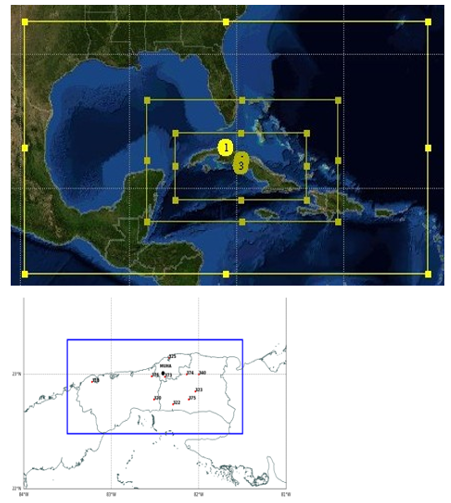Visibility algorithms forecast evaluation applied to Nowcasting Forecast System
Main Article Content
Abstract
This research evaluate the WRF mesoscale model performance, inner core of SisPI project (Nowcasting System), to forecast a fog/haze event ocurred at January 4th, 2019 on a Cuban west portion. For that 8 empirical algorithms that allow estimate the horizontal visibility was employed, introducing modofications to one of thems. Two initialization times was used, for to evaluate how close or far the forecast is more realistic. The evaluation is made with a mesh-point strategy together a binary event analisys. The fog/haze events was analized combined way, caused by the visibility measurements have an important subjective component. The forecasted fog/haze events was shorter comparing with the observations. The wind field overestimation is considered the main limitant factor for obtain more realistics forecasts and conductive for earlier dissipations. The results suggests that the relative humidity and dew point depression algorithms give more realistics forecast on the study area. In these cases the inclusion of an inibition wind shear factor is conductive to betters forecast.
Downloads
Article Details

This work is licensed under a Creative Commons Attribution-NonCommercial 4.0 International License.
Those authors who have publications with this journal accept the following terms of the License Attribution-NonCommercial 4.0 International (CC BY-NC 4.0):
You are free to:
- Share — copy and redistribute the material in any medium or format
- Adapt — remix, transform, and build upon the material
The licensor cannot revoke these freedoms as long as you follow the license terms.
Under the following terms:
- Attribution — You must give appropriate credit, provide a link to the license, and indicate if changes were made. You may do so in any reasonable manner, but not in any way that suggests the licensor endorses you or your use.
- NonCommercial — You may not use the material for commercial purposes.
- No additional restrictions — You may not apply legal terms or technological measures that legally restrict others from doing anything the license permits.
The journal is not responsible for the opinions and concepts expressed in the works, they are the sole responsibility of the authors. The Editor, with the assistance of the Editorial Committee, reserves the right to suggest or request advisable or necessary modifications. They are accepted to publish original scientific papers, research results of interest that have not been published or sent to another journal for the same purpose.
The mention of trademarks of equipment, instruments or specific materials is for identification purposes, and there is no promotional commitment in relation to them, neither by the authors nor by the publisher.
References
Alfonso A. P. (1980): Descripción preliminar de las condiciones meteorológicas en la Isla de la Juventud. Informe Científico - Técnico. Instituto de Meteorología No. 134, 25 pp.
Alfonso A. P.; A. Florido (1993): El clima de Matanzas. Editorial Academia, La Habana, 113 pp.
Álvarez, E. L.; Borrajero, M. I.; Álvarez, M. R. & León, L. A. (2011ª). “Estudio de la marcha interanual de la frecuencia de ocurrencia de los fenómenos nieblas y neblinas a partir del código de estado de tiempo presente”. Revista Ciencias de la Tierra y el Espacio , (12): 31–46, ISSN: 1729-3790
Bergot T.; D. Guedalia (1993): Numerical Forecasting of Radiation Fog. Part I: Numerical Model and Sensitivity Tests. MWR, Vol. 122, No. 6, 12181230. DOI: 10.1175/1520-0493(1994)
Creighton G.; Kuchera E.; McCormick J.; Rentschler S.; Wickard B. (2014): AFWA Diagnostics in WRF. https://www2.mmm.ucar.edu/wrf/users/docs/
Gultepe I.; Müller M. D.; Boybeyi Z. (2006): A new visibility parametrization for warm fog applications in Numerical Weather Prediction Models. Journal of Applied Meteorology and Climatology, Volume 45.
Gultepe I. and Milbrandt J. A. (2009): Probabilistic parametrizations of visibility using observations of rain precipitations rate, relative humidity and visibility. Journal of Applied Meteorology and Climatology, Volume 49. DOI: 10.1175/2009JAMC1927.1
de Paula, Norton Franciscatto; Scremin Puhales, Franciano; Anabor, Vagner; Dal Piva, Everson; de Lima Nascimento, Ernani (2015): Mean weather characteristics associated to radiation fog at Santa Maria–RS. Ciência e Natura, Santa Maria v.37 n.3, 2015, Set.- Dez. p. 613 – 624 Revista do Centro de Ciências Naturais e Exatas – UFSM ISSN impressa: 0100-8307 ISSN on-line: 2179-460X. DOI:10.5902/2179-460X17277.
Jansá Guardiola J. M. (1974): Curso de Climatología. Instituto Cubano del Libro, La Habana,445 pp.
Kunkel, B. A.: Parametrization of droplet terminal velocity and extinction coefficient in fog models, J. Clim. Appl. Meteorol., 23, 34–41, 1984.
Ledesma, M. & Baleriola, G. 2003. Meteorología aplicada a la aviación. 12th ed., Madrid: Thomson Paraninfo, 602 p. ISBN: 978-84-283-2840-1
Maura L., Rojas Y., Carnesoltas M., Rubio C., Laborde N., Perigó E., Baza R. (2008): Comportamiento de la niebla en la provincia de Guantánamo
Ryerson William R. (2012): Toward improving short-range fog prediction in data-denied areas using the Air Force Agency Mesoscale Ensemble. https://calhoun.nps.edu/handle/10945/17454.
Sierra et. al. (2014) Sistema de Predicción a muy corto plazo basado en el Acoplamiento de Modelos de Alta Resolución y Asimilación de Datos. Informe de resultado. Programa: “Meteorología y Desarrollo Sostenible del País”. Instituto de Meteorología. DOI: 10.13140/RG.2.1.2888.1127 https://modelos.insmet.cu/static/models/docs/.
Sosa M.; O. Rodríguez; R. Hernández (1992): Las nieblas en las Provincias Habaneras. Revista Cubana de Meteorología, Vol. 5, No. 2, pp 28 34.
Stoelinga, M. T., and T. T. Warner, 1999: Nonhydrostatic, Mesobeta-scale model simulations of cloud ceiling and visibility for an east coast winter precipitation event. J. Appl. Meteor., 38, 385- 404.
Wang et al (2013): Assimilating MTSAT-Derived Humidity in Nowcasting Sea Fog over the Yellow Sea. DOI: 10.1175/WAF-D-12-00123.1
WMO (1992): Vocabulario Meteorológico Mundial (1992). OMM No. 182, 784 pp.

